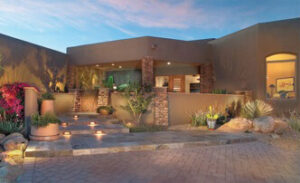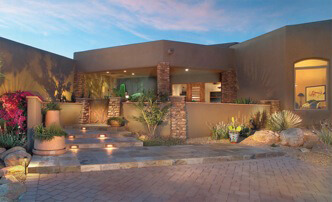Landscape lighting can elevate your home’s outdoor space and make it usable at night. But even the best landscape lighting systems require maintenance.

A few simple tools and some know-how can solve most landscape lighting problems. The most common issues are a bad light bulb, loose wire connections, or corroded sockets. For professional help, call Landscape Lighting Repair Orlando now!
Landscape lighting fixtures are exposed to sun, wind, rain, and other elements daily. They also need to withstand nibbling insects and invasive landscaping. Over time, high-quality copper and brass landscape lights will develop a natural patina that helps them resist moisture damage. However poorer quality lights can suffer from a variety of problems that are often the result of improper installation or lack of maintenance.
It’s easy to overlook the importance of properly maintaining lighting fixtures. This can lead to a variety of issues, some of which are easily addressed while others are more challenging and require the help of a professional.
One of the easiest and most important steps in maintaining landscape lighting is to cut back plants, shrubs or trees that are too close to a fixture or are blocking light. This can improve illumination, make the outdoor living area look cleaner and increase the life of the fixture by preventing it from overheating.
Corrosion on wire connections or bulb socket contacts is a common problem that can affect a low voltage lighting system. It is important to clean the corrosion off of the wires and bulb connections with an emery board or sandpaper before proceeding to repair the fixture. If the wires have corroded to the point where they are exposed, you should contact an electrician for immediate repair.
You should also test the voltage level of each light fixture with a digital voltmeter to ensure they are getting the correct amount of power. Extremely low readings may indicate a bad connection on the transformer or too many lights on a circuit.
The transformer is the heart of a landscape lighting system. It provides a safe voltage to each fixture through wire connections that should be regularly checked and tightened. If the connections in the transformer become loose, they can cause lights to stop working and, in some cases, generate heat that melts wires or can even start fires.
You should also test each fixture’s light output using a voltmeter to make sure they are receiving the proper amount of voltage for a bright, beautiful glow. If you find a light that is not functioning, it is likely the result of a dead bulb and should be replaced.
Wiring
Landscape lighting is the icing on your outdoor home design cake, making your outside look safe and beautiful. However, the system requires a bit of maintenance to function properly. Low-voltage landscape lighting systems use different electrical components including transformers, wiring, light fixtures or bulbs and timers or photocells. These can all go wrong from time to time. The problem usually starts at the transformer, which functions as the power center for the lighting system, sending a safe voltage to each light fixture through wire connections. When these connections become loose, lights fail and can even generate heat that melts the wiring or, in extreme cases, cause fires.
A common problem that many homeowners experience with their landscape lighting is that they can’t get the lights to come on. If you notice a lack of light, the first thing you should try is replacing the bulb in that fixture. This is usually the quickest and easiest way to determine whether or not a light is dead. If a new bulb doesn’t help, then you’ll want to check the socket with a voltmeter.
The wires that connect to the light fixtures can also be a source of problems with your landscape lighting. These can become damaged due to weather, buried in dirt or simply worn out over time. If the wires are corroded, they’ll need to be replaced with new ones. For this, you’ll need to shut off the power to the transformer and remove the old wires with a pair of pliers. Once the wires are removed, use a piece of emery board to lightly file the ends of the wire and clean them before using an automotive ignition sealer to reseal them.
If the splices are buried underground, you may need to dig them up to inspect the splices for damage. In addition to checking for damage, you’ll also need to make sure the splices are tightly connected. If you’re able to see them, you can tighten them with a screwdriver. If you’re unable to see them, it’s a good idea to call a professional to perform a more in-depth inspection of the entire system and its connections.
Connections
A well-lit property deters criminals, which is why security lighting is an essential element of any landscape design. Unfortunately, it cannot do its job if your lights are not working properly. If you are having trouble with your lighting, it could be due to a simple problem like a broken photocell or a damaged fuse that needs to be replaced. The right products, optimal installation methods and routine maintenance are the best ways to reduce your risk of having to repair your landscape lighting.
Most outdoor lighting wiring runs inside a small underground trench, which means that the wire connections are exposed to moisture and other environmental conditions. Over time, this can corrode the connection points, which can then create an electrical short. In order to prevent this, our outdoor lighting technicians use waterproof connectors that are innately designed for low-voltage underground splices.
During routine maintenance, we also look for the areas where shrubs and other plants may be blocking connections. If they are, our team will trim and prune the affected plant to ensure that your light fixture is getting the proper amount of power.
Finally, our technicians also check the individual photocells for signs of damage or wear. The photocells are what tell your system when it’s dark or light out, and they can be easily damaged by lawn care tools or other landscaping items. We also make sure that these photocells are not being blocked by overgrown trees and shrubs, as this can cause the lights to turn on in the middle of the night when you don’t want them to.
Fuse
A fuse is an over current protective device that protects the circuit it is connected to. It is designed to melt when it starts to overheat, thereby stopping the flow of electricity and protecting the circuit. A fuse can last 20 – 30 years or more if it is installed in an appropriate application and not subjected to extreme temperatures.
If you’re having trouble with your landscape lighting system it’s always a good idea to check the connections and fuse before replacing any fixtures. Depending on your comfort level with electrical projects you can do this yourself or get a lighting specialist to take a look at the problem.
The first thing you’ll want to do is make sure that the power is off. This is a great habit to get into with any electrical project. You can turn off the power at the transformer or at your fuse box. Next you’ll want to use a digital voltage meter (about $25 at Radio Shack) and test each light fixture. A low reading means the socket isn’t getting any power and a high reading usually indicates that you have too many lights on one circuit.
It’s also a good idea to inspect the wire connections at the fixture and where it connects to the main line. These can be damaged by dogs digging, harsh weather over time, and sometimes even by landscapers or irrigation specialists who may cut the wires when they are working. Make sure they are clean and tight and if you need to rewire the connections do so using the proper wire connectors as shown in this video.
If your fixtures are still leaking it’s time to replace the gasket. This is an inexpensive part that is a critical element in keeping water out of the fixtures. Leaking fixtures allow moisture to damage the internal components and shortening their lifespan. A good quality gasket should be able to be replaced in about 15 minutes with an adjustable wrench. If you have a lot of fixtures to replace we would suggest calling in a lighting specialist to do the job.


